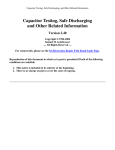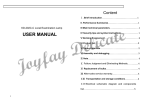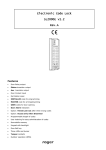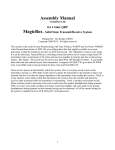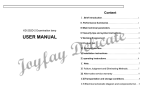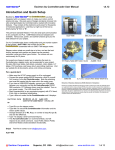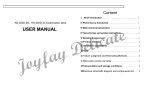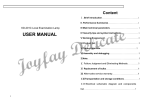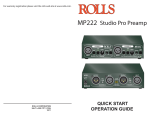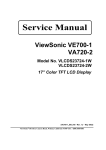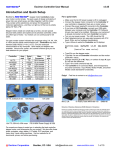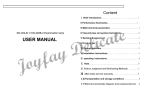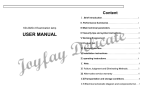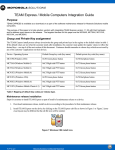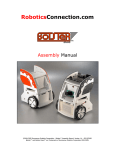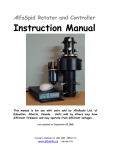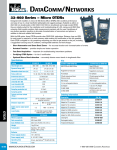Download Four State QRP Group “Ham Can”
Transcript
Four State QRP Group “Ham Can” A 40M Minimalist Transceiver Designed by David Cripe, NMØS Construction and User’s Manual Congratulations on your purchase of the HAM CAN transceiver, the latest offering in minimalist amateur radio from the Four State QRP Group! The HAM CAN is a crystal-controlled CW transceiver, delivering 1/2 to 1W transmit power, with enough sensitivity and selectivity to receive plenty of signals. It does all this with only TWO transistors! Table of Contents Specifications and Description ............................................. Page 2 Parts List ......................................................................... Page 3 Component Installation ..................................................... Page 4 Soldering Tutorial ............................................................. Page 8 Using The Ham Can ............................................................ Page 9 Schematic ........................................................................ Page 10 Keying Circuit for Electronic Keyer ....................................... Page 11 Page 2 of 11 “Ham Can” a 40M Minimalist Transceiver Designed by David Cripe, NMØS Construction and User’s Manual Specifications and Description General Description The ―Ham Can‖ is a minimalist transceiver designed to be very simple and inexpensive, yet provide good performance. The low cost kit sacrifices nothing in the way of quality. It features a high quality printed circuit board, low parts count and fast and easy building. It makes an excellent first kit for first time builder, and for this reason it was chosen as the Build Session kit for OzarkCon 2011. This NMØS design features an innovative power switch. Your straight key plug also serves as the on and off switch, i.e. Just plugging int the hey powers up the rig automatically Designed to be as small as possible and still use through hole parts, it will fit on top of a 3 oz ham snack can, while a 9 volt battery resides inside the can, thus making self contained portable rig. Brand names with cans this size are Armour, Bryan, Fancy Feast and probably many others. The builder can enjoy a snack while obtaining the enclosure :o) Receiver Crystal-oscillator-filter design - Smooth and easy regeneration control due to 25 turn pot - Direct conversion - Crystal controlled on 7122 kc Adequate sensitivity for 40M - Audio stage drives earpones Transmitter Keyed oscillator operating in class C - .5 to 1 watt output into 50 ohms VCC keying - pleasing bell like signal - Page 3 of 11 “Ham Can” a 40M Minimalist Transceiver Designed by David Cripe, NMØS Construction and User’s Manual Part List Let's begin construction by taking an inventory of components: C1 C2 C3 C4 C5 C6 C7 C8 C9 C10 ( ( ( ( ( ( ( ( ( ) ) ) ) ) ) ) ) ) D1 D2 D3 D4 ( ( ( ( ) ) ) ) L1 L2 L3 () () Q1 Q2 () () 2N3866 2N3904 R1 R2 () () 1.0k 27k brown-black-red red-violet-orange R3 R4 () () 10k 220k 10-turn pot red-red-yellow T1 T2 () () T50-2 1k:8 ohm audio X1 () 7.122 MHz J1 J2 J3 J4 HS () () () () () 1/8 Stereo Jack (Key) 1/8 Stereo Jack (Phone) RCA Jack (Ant) 9v Battery Clip Heat Sink 26 AWG 22 AWG PC Board 680p 681J 220p 221J 10p 100J 1000p 102J Not Used - Jumper Out 0.047 u 473j 0.47u 0.47uF Electrolytic 1000p 102J 470u 470uF Electrolytic Not Used - Leave Open 1N4148 1N4148 1N4148 1N4148 T50-2 T50-2 Not Used - Leave Open () () () 3' 2' Page 4 of 11 “Ham Can” a 40M Minimalist Transceiver Designed by David Cripe, NMØS Construction and User‘s Manual Component Installation WINDING THE COILS Let's begin construction! Start off by winding the toroids. Yeah, those are the least fun part of the whole project, and take the most attention to detail, but once they are wound, it is all downhill from there. There are three toroids to wind. Starting with L1, this is wound with 22 turns of 26 gauge magnet wire. This is the thinner of the two pieces of magnet wire included in the kit. Cut off about two feet from the piece, and wind it in the direction shown in the diagram above. Make sure the wire is pulled snug against the toroid coil form, without any kinks, and that the turns are evenly distributed around the core. Turns are counted as the number of times the wire passes through the center of the core. Next, cut the 22 gauge wire in half, and wind L2 with 11 turns, in the same manner as L1. Finally, we need to wind T1, the RF transformer. The core is wound with two windings of 11 turns each, one of 22 gauge for the primary, and one of 26 gauge wire for the secondary. Start with the 22 gauge primary, and wind it per the diagram. When finished with this, wind the secondary so that it lies in between turns of the primary, flush to the core without crossing any of the primary windings. Double check when finished to be sure that both primary and secondary have 11 turns each. Cut the legs of each coil so that there is about ½ inch remaining, and set them aside until later. Now that the hard part is over, let‘s start soldering! Page 5 of 11 “Ham Can” a 40M Minimalist Transceiver Designed by David Cripe, NMØS Construction and User‘s Manual Component Installation Cont’d The component identification and mounting locations are silk screened on the component side of the PCB. Check off each part as you install them. Install and solder one part at a time, clipping the leads flush with the back of the board. Capacitors We‘ll start by installing capacitors. Their value is designated by the code printed on them. Locate the capacitors, and insert them into the board, spreading their legs slightly at the bottom to keep them from falling back out when the board is inverted. Solder them in, and trim their leads flush with the board. Mark them off the list as they are installed. C1 C2 C3 C4 C5 ( ( ( ( ( ) ) ) ) ) 680p 220p 10p 1000p C6 C7 C8 C9 ( ( ( ( ) ) ) ) 0.047u 0.47u 1000p 470u 681J 221J 100J 102J Not Used - Jumper out using component lead 473j 0.47 102J 470 Diodes Next, the diodes are to be installed. They are all the same type, so there is no chance for confusion, but they need to be inserted into the board so that their body stripes line up with the stripe on the silk screen board marking. D1 D2 D3 D4 ( ( ( ( ) ) ) ) 1N4148 1N4148 1N4148 1N4148 Page 6 of 11 “Ham Can” a 40M Minimalist Transceiver Designed by David Cripe, NMØS Construction and User‘s Manual Component Installation cont’d Resistors Next come the resistors. These are installed in a space-saving ‗hairpin bend‘ manner. The value of the resistors is designated by three color coded bands. A fourth gold band at the right side of the resistor indicates 2% tolerance of the resistor value. Install and solder one at a time, clipping the leads flush with the back of the board when finished. R1 () 1.0k brown-black-red R2 () 27k red-violet-orange R3 () 10k 10-turn pot R4 () 220k red-red-yellow Transistors Be certain that the body of Q1 is spaced above the board by about 1/16‖ so that it DOES NOT contact the board surface. ( ) Q1 - 2N3866 Install with tab on transistor oriented to outline on pcb. ( ) Q2 - 2N3904 Install with flat on transistor oriented to outline on pcb. Audio Transformer Install the audio transformer, T2. Be certain that the primary-side windings are installed into the correct holes. Solder the mounting tabs into the PCB holes as well. ( ) 1K:8 ohms Install with the side marked P oriented toward Q2. Connectors Install the three connectors next. Be certain they are snug against the board before soldering. Do not overheat the Key and Phone jacks so that the plastic bodies of the connectors do not soften. ( ) J1 ( ) J2 ( ) J3 NOTE: the on Key Install 1/8 STEREO jack in KEY position indicated on PCB Antenna Install RCA jack in ANT position indicated on PCB Install 1/8 STEREO jack in PHONES position indicated on PCB A 1/8 MONO plug (as used with a straight key) inserted in the KEY jack serves as and off switch. Toroids We need to install the toroidal coils next. The pigtail wire leads of each coil need to be tinned. The enamel insulation on the magnet wire is solder-strippable, melting clean at the touch of a well-tinned soldering iron. Tin the leads flush to the body of the toroids. If the wires do not strip cleanly, the remaining enamel may be cleaned off by scraping with an XActo knife. Insert the wire pigtails though the holes in the board, and pull them snug before soldering. Page 7 of 11 “Ham Can” a 40M Minimalist Transceiver Designed by David Cripe, NMØS Construction and User’s Manual Installing Components Cont’d Toroids (con’t) RF transformer T1 requires special care in its installation. The 26 gauge secondary winding is to be inserted into the ROUND holes on the board. The 22 gauge primary leads are to be installed in the SQUARE holes on the board. If they don‘t line up, make sure to place the correct windings in the correct holes. See picture below for clarification.. Primary Green #22 Secondary Red #26 Crystal ( ) 7122 HC-46 Install in crystal outine adjacent to the 2N3866 Some builders may make a socket from an IC machined pin socket. 9 Volt Power Leads ( ) install POSITIVE lead into the SQUARE hole close to key jack, Page 8 of 11 “Ham Can” a 40M Minimalist Transceiver Designed by David Cripe, NMØS Construction and User’s Manual Soldering Know How Because of the simplicity of this kit, it will have appeal as a first project for beginning kit-builders. For those with little or no experience with soldering, there are a few things to keep in mind before starting. It is recommended that a low wattage, 25 to 30 watt, pencil-tip soldering iron be used. Only rosin-core solder may be used, as acid core plumbers solder will corrode the board and components. Either lead-free or tinlead solder may be used, though the builder should be aware of the potential toxicity of lead-based solders. Soldering is not hard if the proper procedure is followed. The soldering iron is to be used to heat up the bottom side of the board PC pad and component lead, and the solder applied to the pad, where it melts and flows into the hole. Do not melt the solder onto the tip of the iron and then attempt to dab it onto the joint – a defective connection will result! After soldering, check the top (component side) of the board, to be sure the solder has filed the hole completely, and wicked up around the component lead. Re-heat and apply more solder if necessary. Burned flux and solder residue will accumulate on the soldering iron tip and lead to dirty solder joints if not kept clean. Periodically wipe the soldering iron tip on a dampened sponge to clean it. The PC board has the reference designators for the component mounting locations in silk-screened lettering on the component side of the PCB. Page 9 of 11 “Ham Can” a 40M Minimalist Transceiver Designed by David Cripe, NMØS Construction and User’s Manual Using the Ham Can To begin, turn the regeneration control R3 fully clockwise. Note: there is no stop, listen for a light click. The 1/8‖ MONO key plug connects 9v battery power to the circuit— unplug when not in use. Plug in the antenna (matched to 1:1 SWR), earphones, and a straight key, do not use your electronic keyer. This rig requires a special keying circuit (described later), or a straight key. Snap in a 9 volt battery if you used a clip, or hook up leads from a 9 volt power supply (do not use higher voltage ) OBSERVE POLARITY, there is no protection diode on the board. Add one in the 9 volt line if you wish, any 1 amp diode will work fine (1N400x). The Ham Can does not have a sidetone, so all you will hear is keyclicks on TX. The regen is very smooth, and you will not hear any clicks when the RF oscillation commences. If you are connected to an antenna when the band is active, you will hear stations start to come in, and you will also hear the rig's oscillation on a nearby CW receiver. Adjust the 10K trimpot (R3) regeneration control if needed. Start with pot fully Clockwise, then rotate counter clockwise until receiver regeneration begins. This will be heard as a weak signal on your big rig, or you will hear signals and band noise. Once oscillation begins, turn the pot one or two more turns counterclockwise to bring receiver volume to max. You should not need to readjust this pot setting unless the battery voltage droops. When it does, then another 1-2 CCW turns will be necessary to again peak the receiver volume. Press straight key - the xmitter should be making 1/2 to 1 watt of power. You will be able to hear receiver signals while you are transmitting! How‘s that for full QSK? Page 10 of 11 “Ham Can” a 40M Minimalist Transceiver Designed by David Cripe, NMØS Construction and User’s Manual 39k 2N3866 Page 11 of 11 “Ham Can” a 40M Minimalist Transceiver Designed by David Cripe, NMØS Construction and User’s Manual Keying Circuit For Electronic Keyers Isolate 9v and ground from the Ham Can‘s power supply 9v Or use 4.5—5 volts with no dropping resistor. Rs To Key Jack On Ham Can 5v Reed Relay 1/8 Mono Keyer 2N3906 A reed relay keys the Ham Can nicely. Almost any reed relay can be used. The first one tried was a Radio Shack #275-232, another suitable one is the Coto 9007, Mouser # 816-9007-05-01. These are 5 volt relays and need the dropping resistor Rs. Rs=4 volts divided by the coil current in amps. Some relays have an internal spike snubbing diode, add an external one if your‘s doesn‘t. Double click the link below to hear an on the air recording of the Ham Can‘s signal.











